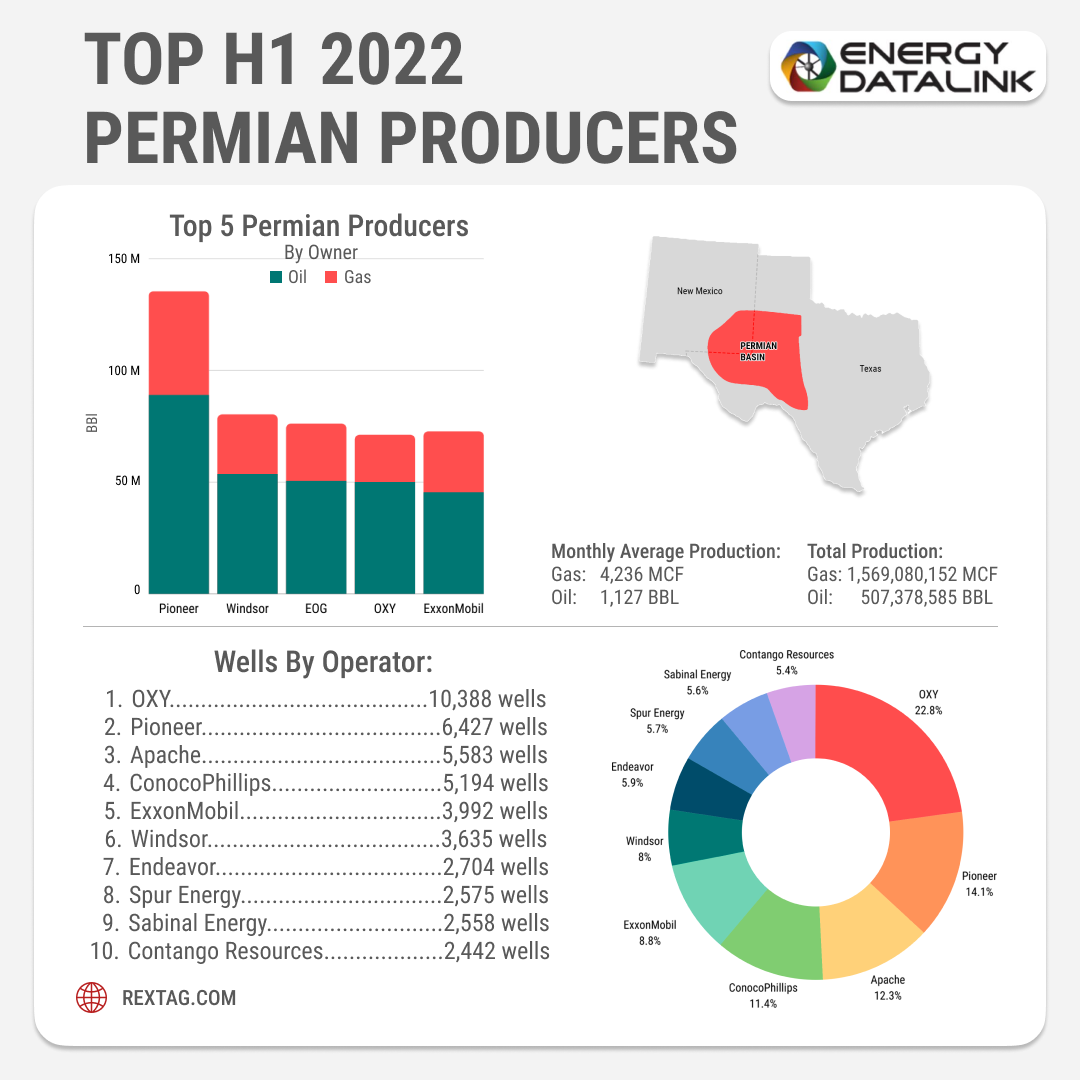Comprehensive Energy Data Intelligence
Information About Energy Companies, Their Assets, Market Deals, Industry Documents and More...
Top H1 2022 Permian Producers
12/22/2022
The year 2022 brought new opportunities to the U.S. economy in different domains that were not perfectly developed. Oil and natural gas production facilitated economic growth, especially in the Permian Basin.
Compared with other U.S. basins, the Permian Basin derives benefits from lower operational costs, better access to oilfield services, and its proximity to U.S. Gulf Coast refineries and export facilities. Core areas of the Permian Basin, and its Delaware and Midland subbasins, consist of multiple stacked shale formations.
According to the U.S. Energy Information Administration (EIA), oil output in the Permian in Texas and New Mexico, the biggest U.S. shale oil basin, is predicted to grow by almost 50,000 barrels per day (bpd) to a record 5.453 million bpd in November.
In 2022 the total production is 1.6 billion MCF for gas and 507 million BBL for oil. Furthermore, the monthly average production in Permian Basin is 4,236 MCF for gas and 1,127 BBL for oil. The list of the top 5 Permian producers is the following: Pioneer, Windsor, EDG, OXY, and ExxonMobil.
For the time being, OXY has the most significant number of wells (10,388) that are delivering steady production to domestic and foreign customers. Other top producers operate roughly twice as fewer wells (4,000-6000).
In 2023 it is anticipated strong production growth from the Permian basin, generating first-half 2022 average crude oil production of 5.02 million b/d, a growth of 13.6% year-over-year. Constant supply chain bottlenecks, shortages of qualified personnel, and a fluctuating drilled-but-uncompleted (DUC) well inventory could dampen overall expectations, but the play concentrates on many US shale operators.
If you are looking for more information about energy companies, their assets, and energy deals, please, contact our sales office mapping@hartenergy.com, Tel. 619-349-4970 or SCHEDULE A DEMO to learn how Rextag can help you leverage energy data for your business.
Non-core Permian assets to be sold for $160 million by Diamondback Energy in a massive Drop-Down Transaction
![$data['article']['post_image_alt']](https://images2.rextag.com/public/blog/Diamondback_Energy_Rattler_Midstream_Permian_Basin_water_management_produced_water.png)
Diamondback Energy is willing to sell some of its Permian Water Assets in order to reduce debt and ensure a steady oil supply through the end of the year. The brokered deal will bring the company some $160 million in cash. Consolidation seems to be the trend in the industry, but for how long?
Occidental to Streamline Operations with $20 Billion Western Midstream Sale?
![$data['article']['post_image_alt']](https://images2.rextag.com/public/blog/H245_Blog_Occidental to Streamline Operations with $20 Billion Western Midstream Sale_.png)
Occidental Petroleum is looking into selling Western Midstream Partners. OXY focuses on natural gas pipelines in the U.S. and is worth around $20 billion, including its debt. This sale could help the company cut down its large debt of $18.5 billion, which grew due to buying other companies. Recently, Occidental agreed to buy CrownRock for $12 billion, adding more debt to its books. This comes after its huge $54 billion purchase of Anadarko Petroleum four years ago. The news about possibly selling Western Midstream made its shares go up by 5.7% to $30.81, reaching their highest value since July 2019. However, Occidental's shares fell by 1.6% to $59.56, as part of a wider drop among energy companies.
![$data['article']['post_image_alt']](https://images2.rextag.com/public/blog/328_Blog_Why Are Oil Giants Backing Away from Green Energy Exxon Mobil, BP, Shell and more .jpg)
As world leaders gather at the COP29 climate summit, a surprising trend is emerging: some of the biggest oil companies are scaling back their renewable energy efforts. Why? The answer is simple—profits. Fossil fuels deliver higher returns than renewables, reshaping priorities across the energy industry.
![$data['article']['post_image_alt']](https://images2.rextag.com/public/blog/327_Blog_Oil Market Outlook A Year of Growth but Slower Than Before.jpg)
The global oil market is full of potential but also fraught with challenges. Demand and production are climbing to impressive levels, yet prices remain surprisingly low. What’s driving these mixed signals, and what role does the U.S. play?
![$data['article']['post_image_alt']](https://images2.rextag.com/public/blog/326_Blog_USA Estimated Annual Rail CO2 Emissions 2035.jpg)
Shell overturned a landmark court order demanding it cut emissions by nearly half. Is this a victory for Big Oil or just a delay in the climate accountability movement?